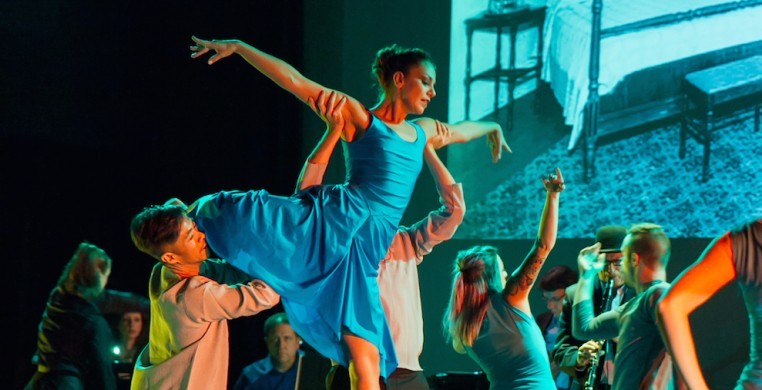Cerqua Rivera Dance Theatre’s “Inside/Out 2015,” presented last Thursday as part of the Harold Washington Library’s “Made In Chicago” series, was billed as the launch of new works by company members. In fact, the informal program, moderated by company artistic director Wilfredo Rivera, was hardly a launch, but instead gave a modest, user-friendly preview of five works-in-progress plus an excerpt from company repertory. Some of these amounted to a few germinating movement phrases in very early stages of development, disconnected or loosely strung together, some improvised segments with live, improvised music, and a couple passages of more fully-developed material, including an excerpt from Rivera’s choreographic memoir, “Requerdos.”
The able dancers were pleasing enough to watch, and the work promising enough to whet the appetite for the finished products, to be formally launched in the company’s October 2015 season.
Marc Macaranos’ “Elastics Splash,” charmingly danced by Daniel Chenowith and Connor Cornelius, promises an entertaining contemporary jazz hybrid of 30’s and 40’s swing dance. “Elixir,” set to Cerqua’s original score, intrigues with spoken words and mime to evoke early 20th-century magic the likes of Houdini, as eight dancers circle arms in a facsimile of magical linking rings. Raphaelle Ziemba’s movement study on a rolling Eames chair, set to blues music, holds interest for the future.
The program, clearly not intended as a formal dance concert, felt like it wanted to be an interactive lecture/demonstration about the art of making dances. That it didn’t quite get there was the result of a too-loose structure that lacked focus and clear learning objectives, and a too-tepid approach to audience participation, two problems that could be easily rectified by capitalizing on CRDT’s most distinctive assets: its commitment to the collaboration of musicians and dancers and the integration of visual art.
For this scaled-down event, we were treated to three of CRDT’s superb musicians performing original music live on stage: co-founder and resident composer and vocalist Joe Cerqua, violinist James Sanders, and Leandro Lopez Varady on piano and keyboard. Recorded music filled in where the full compliment of CRDT musicians was called for. Projections of historic photographs, paintings and graphic art provided visual commentary and context.
One couldn’t help but wonder how the collaborations work. Giving the audience an inside look at how music and dance interact in the creative process, how sound and movement influence each other, and what factors go into movement and musical invention--such as volume, texture, weight, shape, speed, rhythm, melody, and effort--would be fascinating to any audience.
This particular audience was comprised of two groups of young children from Greeley and Murphy elementary schools and a dozen or so adult concert patrons. Rivera and each of the choreographers focused their commentary on the children, giving a general idea of what each piece was about, but without providing a basic critical framework for looking at dance or listening to music. Many seasoned adult concert goers could benefit as much as any third grader from such tools. One would have relished each of the choreographers isolating one particular movement element and then inviting the audience to watch for it as it played out in a dance phrase.
It looked as if Rachel Pike’s “Memory” was heading in that direction when she asked the children to shout out action words for the dancers to respond to, and then to observe how the dancers’ relationship is altered by the switch of intention. What fun! More of this would have heightened both entertainment and educational value. The same goes for Connor Cornelius’ duet purportedly about hunger, in which Cornelius asked the audience to shout out words which the movement suggested to them. With a little prodding, the audience came up with “Mad,” Strength,” and “Pushing.” Following through a bit more with fuller exploration of these ideas would have added richness to the program as well.
(Disclaimer: without a printed program, it was not always easy to catch the title of each piece or the names of choreographers, composers, and dancers.)

